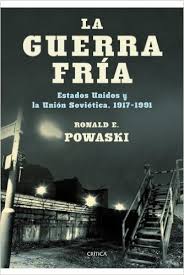LECTURAS NOVELESCAS
Se puede leer el original, o en su caso ambientarse conociendo más de la época a través de dos ensayos que abordan todos los aspectos relacionados con un momento histórico muy propicio para los secretos, traiciones e ideales.
STRANGERS
ON A BRIDGE, James Donovan.
"Originally
published in 1964, this is the enthralling truly remarkable ("The
New York Times Book Review") insider account of the Cold War spy
exchange with a new foreword by Jason Matthews, "New York Times"
bestselling author of "Red Sparrow" and "Palace of
Treason."
In the early morning of February 10, 1962, James B. Donovan began his walk toward the center of the Glienicke Bridge, the famous Bridge of Spies which then linked West Berlin to East. With him, walked Rudolf Ivanovich Abel, master spy and for years the chief of Soviet espionage in the United States. Approaching them from the other side, under equally heavy guard, was Francis Gary Powers, the American U-2 spy plane pilot famously shot down by the Soviets, whose exchange for Abel Donovan had negotiated. These were the strangers on a bridge, men of East and West, representatives of two opposed worlds meeting in a moment of high drama.
Abel was the most gifted, the most mysterious, the most effective spy in his time. His trial, which began in a Brooklyn United States District Court and ended in the Supreme Court of the United States, chillingly revealed the methods and successes of Soviet espionage.
No one was better equipped to tell the whole absorbing history than James B. Donovan, who was appointed to defend one of his country s enemies and did so with scrupulous skill. In "Strangers on a Bridge," the lead prosecutor in the Nuremburg Trials offers a clear-eyed and fast-paced memoir that is part procedural drama, part dark character study and reads like a noirish espionage thriller. From the first interview with Abel to the exchange on the bridge in Berlin and featuring unseen photographs of Donovan and Abel as well as trial notes and sketches drawn from Abel s prison cell here is an important historical narrative that is as fascinating as it is exciting ("The Houston Chronicle")."
In the early morning of February 10, 1962, James B. Donovan began his walk toward the center of the Glienicke Bridge, the famous Bridge of Spies which then linked West Berlin to East. With him, walked Rudolf Ivanovich Abel, master spy and for years the chief of Soviet espionage in the United States. Approaching them from the other side, under equally heavy guard, was Francis Gary Powers, the American U-2 spy plane pilot famously shot down by the Soviets, whose exchange for Abel Donovan had negotiated. These were the strangers on a bridge, men of East and West, representatives of two opposed worlds meeting in a moment of high drama.
Abel was the most gifted, the most mysterious, the most effective spy in his time. His trial, which began in a Brooklyn United States District Court and ended in the Supreme Court of the United States, chillingly revealed the methods and successes of Soviet espionage.
No one was better equipped to tell the whole absorbing history than James B. Donovan, who was appointed to defend one of his country s enemies and did so with scrupulous skill. In "Strangers on a Bridge," the lead prosecutor in the Nuremburg Trials offers a clear-eyed and fast-paced memoir that is part procedural drama, part dark character study and reads like a noirish espionage thriller. From the first interview with Abel to the exchange on the bridge in Berlin and featuring unseen photographs of Donovan and Abel as well as trial notes and sketches drawn from Abel s prison cell here is an important historical narrative that is as fascinating as it is exciting ("The Houston Chronicle")."
LA
GUERRA FRÍA: UNA BREVE INTRODUCCIÓN, Robert McMahon. Alianza, 2009
"Con
la derrota de las potencias del Eje y el fin de la Segunda Guerra
Mundial comenzaron a evidenciarse las profundas diferencias
existentes –ideológicas, políticas, socioeconómicas,
geoestratégicas– entre los miembros de la coalición triunfante.
Bajo la amenaza real de un posible enfrentamiento nuclear, dos
modelos bien diferenciados de sociedad –la occidental capitalista,
encabezada por Estados Unidos, y la soviética comunista, abanderada
por la Unión Soviética– trataron de imponer sus criterios en un
mundo sometido a un intenso proceso de cambio tras la sangrienta
conflagración mundial y el nacimiento de la descolonización en los
países del llamado Tercer Mundo. ROBERT McMAHON realiza una
detallada síntesis de este periodo en LA GUERRA FRÍA: UNA BREVE
INTRODUCCIÓN, mostrando no sólo la evolución en sí de la
contienda, con sus diferentes periodos y crisis (Berlín, Corea,
Cuba, Vietnam...), sino atendiendo a las repercusiones y fisuras que
hubo dentro de cada bloque, y a la íntima relación que la política
interior tuvo en las decisiones tomadas por norteamericanos y
soviéticos en el ámbito internacional"
LA
GUERRA FRÍA: ESTADOS UNIDOS Y LA UNIÓN SOVIÉTICA, 1917-1991.
Ronald E. Powaski. Crítica. 2000
"La
“guerra fría” ha sido el acontecimiento central de la segunda
mitad del siglo XX: una confrontación que ha abarcado la totalidad
del planeta y ha tenido consecuencias decisivas en todos los campos
de la actividad humana. Resulta imposible comprender el mundo actual,
si no entendemos cómo surgió -en unos orígenes que arrancan del
gran miedo a la revolución bolchevique- y cómo se ha desarrollado a
lo largo de cerca de cincuenta años. Ha sido preciso, sin embargo,
que la guerra fría llegara a su fin para que podamos tener, en este
gran libro de Ronald E. Powaski, la primera visión informada y
objetiva de todo el proceso, que nos invita a reflexionar acerca de
los costes sociales que estamos pagando, y pagaremos en el futuro,
por los gigantescos gastos de un conflicto que, con sus millones de
muertos en Corea, Vietnam, Indonesia o el Congo, nos parece hoy menos
“frío” de lo que el tópico pretende"



No hay comentarios:
Publicar un comentario